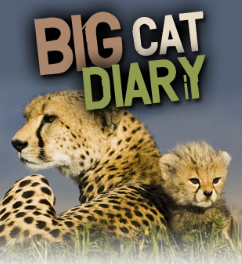Cheetahs, the fastest land animals, have long captured the imagination of wildlife enthusiasts and researchers alike. Known for their incredible speed, agility, and distinctive markings, cheetahs are fascinating creatures that roam the savannas and grasslands of Africa. The “Big Cat Diary” series, a beloved wildlife documentary, has brought the lives of these magnificent predators into the homes of millions. This article delves into the intriguing world of cheetahs, exploring the names of these remarkable cats as documented in the series, the significance of these names, and the unique stories behind each cheetah.

The Fascinating World of Cheetahs
Physical Characteristics
Cheetahs are easily recognizable by their slender bodies, deep chest, spotted coat, small head, high-set eyes, and distinctive tear-like black lines running from the inner corners of their eyes down to the sides of their mouth. These lines help protect the cheetah’s eyes from the sun’s glare and aid in focusing attention on their prey.
Habitat and Range
Cheetahs primarily inhabit the open savannas and grasslands of sub-Saharan Africa. They prefer areas with tall grasses and open spaces where they can utilize their speed to hunt. Although historically found across a much broader range, including parts of the Middle East and India, today, cheetah populations are primarily concentrated in Africa, with a small population in Iran.
Behavior and Social Structure
Cheetahs are unique among big cats in their social structure. While many big cats are solitary, cheetahs exhibit a range of social behaviors. Female cheetahs are usually solitary, except when raising cubs. Males, on the other hand, often form coalitions with their brothers or other males. These coalitions help them control larger territories and hunt more effectively.
Big Cat Diary: A Glimpse into Cheetah Lives
The Concept of Big Cat Diary
“Big Cat Diary” is a wildlife documentary series produced by the BBC, showcasing the lives of big cats in Kenya’s Maasai Mara. The series offers viewers an intimate look at the daily lives, struggles, and triumphs of cheetahs, lions, and leopards. Through the eyes of seasoned wildlife filmmakers and presenters, audiences gain insight into the behavior, ecology, and individual stories of these magnificent animals.
Notable Cheetahs of Big Cat Diary
The cheetahs featured in “Big Cat Diary” have become celebrities in their own right. Each cheetah is given a unique name, often reflecting their physical characteristics, behavior, or the circumstances of their discovery. These names not only help researchers and viewers identify individual cheetahs but also create a personal connection with these animals.
Kike
Kike, a female cheetah, is one of the most memorable cheetahs featured in “Big Cat Diary.” Known for her incredible hunting skills and dedication as a mother, Kike’s story captivated audiences. Her name, meaning “blessing” in Swahili, reflects the gratitude of the filmmakers and researchers for the opportunity to document her life.
Honey
Honey, another prominent female cheetah, earned her name due to her sweet and gentle nature. Her calm demeanor and strong maternal instincts made her a favorite among viewers. Honey’s story is a testament to the challenges and triumphs of raising cubs in the wild.
Amber
Amber, recognized by her striking amber-colored eyes, was known for her fierce determination and resilience. Her name aptly reflects her fiery spirit and the unique color of her eyes, which set her apart from other cheetahs.
The Importance of Naming Cheetahs
Identification and Research
Naming cheetahs is not merely a sentimental gesture but an essential tool for researchers and conservationists. Individual names allow for easier identification and tracking, enabling scientists to gather valuable data on each cheetah’s behavior, health, and movements. This information is crucial for understanding cheetah ecology and developing effective conservation strategies.
Building Public Engagement
Names also play a significant role in building public engagement and support for conservation efforts. By giving cheetahs names, filmmakers and researchers create a personal connection between the animals and the audience. This connection fosters empathy and a deeper understanding of the challenges faced by cheetahs in the wild, encouraging viewers to support conservation initiatives.
Cheetah Conservation Challenges
Habitat Loss
One of the most significant threats to cheetah populations is habitat loss. As human populations expand, agricultural and urban development encroach on cheetah habitats, reducing the available space for these animals to live and hunt. Conservation efforts focus on protecting and restoring natural habitats to ensure cheetahs have the space they need to thrive.
Human-Wildlife Conflict
Cheetahs often come into conflict with humans, particularly farmers and livestock owners. When cheetahs prey on livestock, they are frequently killed in retaliation. Conservation programs aim to mitigate these conflicts by promoting coexistence strategies, such as improved livestock management practices and community-based conservation initiatives.
Poaching and Illegal Trade
Although cheetahs are not typically targeted by poachers for their body parts, they are still affected by illegal wildlife trade. Cheetah cubs are sometimes captured and sold as exotic pets, a practice that is detrimental to wild populations. Conservation efforts include raising awareness about the illegal pet trade and strengthening legal protections for cheetahs.
Genetic Bottlenecks
Cheetahs suffer from a lack of genetic diversity, which makes them more susceptible to diseases and reduces their adaptability to changing environments. Conservationists are working to address this issue through carefully managed breeding programs and habitat corridors that allow for gene flow between isolated populations.
The Role of Big Cat Diary in Cheetah Conservation
Raising Awareness
“Big Cat Diary” has played a significant role in raising awareness about cheetah conservation. By showcasing the lives of individual cheetahs and the challenges they face, the series has educated millions of viewers about the importance of protecting these magnificent animals and their habitats.
Inspiring Action
The emotional connection viewers develop with the cheetahs in “Big Cat Diary” often inspires them to take action. Many viewers support conservation organizations, donate to wildlife protection initiatives, and advocate for policies that benefit cheetahs and other endangered species.
Providing Valuable Data
The extensive footage and observations collected during the filming of “Big Cat Diary” have provided researchers with valuable data on cheetah behavior, ecology, and population dynamics. This information contributes to the broader scientific understanding of cheetahs and informs conservation strategies.
The Future of Cheetah Conservation
Community-Based Conservation
One of the most promising approaches to cheetah conservation is community-based conservation. By involving local communities in conservation efforts, these programs create sustainable solutions that benefit both people and wildlife. Initiatives such as eco-tourism, community conservancies, and education programs help to reduce human-wildlife conflict and provide economic incentives for conservation.
Technological Innovations
Advances in technology are also playing a crucial role in cheetah conservation. GPS collars, camera traps, and drones are used to monitor cheetah populations and gather data on their movements and behavior. These tools help researchers track cheetahs in real-time, identify critical habitats, and respond quickly to threats.
International Collaboration
Cheetah conservation is a global effort that requires international collaboration. Organizations such as the Cheetah Conservation Fund, Panthera, and the Wildlife Conservation Society work together with governments, researchers, and local communities to protect cheetah populations across their range. By sharing knowledge, resources, and expertise, these organizations are making significant strides in cheetah conservation.
Conclusion
Cheetahs, with their remarkable speed and unique beauty, are truly one of nature’s wonders. The “Big Cat Diary” series has given us an intimate look into the lives of these incredible animals, allowing us to appreciate their challenges and triumphs. By understanding the significance of naming cheetahs and the importance of conservation efforts, we can contribute to the protection and preservation of these magnificent creatures for future generations.
FAQs
Q: Why are cheetahs so fast? A: Cheetahs have specialized adaptations that make them incredibly fast, including a lightweight frame, long legs, a flexible spine, and large nasal passages for increased oxygen intake.
Q: How do cheetahs hunt? A: Cheetahs rely on their speed and agility to chase down prey. They use their keen eyesight to spot prey from a distance, then sprint towards it, tripping it with their front paws and delivering a suffocating bite to the throat.
Q: What is the biggest threat to cheetahs? A: The biggest threats to cheetahs include habitat loss, human-wildlife conflict, poaching, and genetic bottlenecks.
Q: How long do cheetahs live in the wild? A: Cheetahs typically live 10-12 years in the wild, although some individuals can live longer.
Q: How can I help cheetah conservation efforts? A: You can support cheetah conservation efforts by donating to reputable wildlife organizations, advocating for conservation policies, reducing your carbon footprint, and spreading awareness about the plight of cheetahs.
Additional Resources
- Cheetah Conservation Fund: https://cheetah.org
- Panthera: https://panthera.org
- Wildlife Conservation Society: https://wcs.org
- National Geographic: https://nationalgeographic.com
By continuing to learn about and support cheetah conservation, we can help ensure that these incredible animals continue to thrive in the wild.






